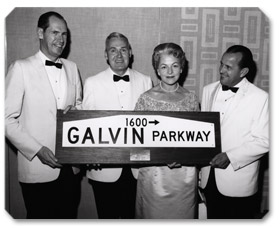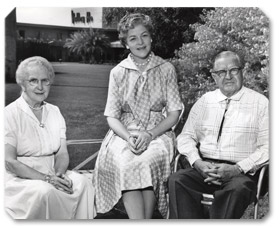|
CHAPTER THREE It is difficult to capture the irresistible, evanescent appeal of tapes made when Virginia was in her early fifties, but there are hints of her need for tranquility, her reflective nature, an occasional weariness from the constant demands upon her, and a mystical reference to the occasional sense of Paul being close by, helping her. Virginia's charm lay in her purity of heart. She was not unsophisticated, but she did possess a disingenuousness, a sweetness of nature. In the tapes, Virginia described to her parents rounds of social outings, parties, and dinners, most of which she seemed to revel in, perhaps as a relief from her work and responsibilities. Virginia adored the arts, and an evening's dramatic or musical entertainment was a thrilling diversion from solitary evenings at home. Whether seeing Charade with Audrey Hepburn and Cary Grant or The Pink Panther with Peter Sellers or the San Francisco Ballet with Rudolf Nureyev and Margot Fonteyn; or underwriting and attending the annual Saint Francis Crusaders Ball with saxophonist Wayne King playing to a sell-out crowd of five hundred guests; or seeing current hit plays such as A Thousand Clowns or Under the Yum Yum Tree; or attending concerts featuring Mitch Miller, Andy Williams, or Fred Waring at the Arie Crown Theater or Abbe Lane and Xavier Cugat at the Palmer House; or sometimes simply watching Perry Como, Danny Kaye, Arthur Godfrey, or the latenight Johnny Carson on television; or listening to Torch Hour radio shows-as Virginia describes all of these, her enthusiasm and informed delight in the arts, in music, theater, and drama is evident. In the mid-'60s, Virginia flew out to Phoenix for the Galvin Parkway dedication, a significant media event attended by Mayor Milton Graham, Governor Samuel P. Goddard, Bob and Mary Galvin, Helen Galvin, and Burley Galvin. Around the same time, 1963 to 1964, Virginia commissioned a portrait from the immensely talented and well-known portrait artist Robert Harris. Virginia wrote about posing for her portrait at his studio in Scottsdale. The following is an excerpt from Virginia's "Portrait Notes," addressed as a letter to an unknown recipient and found among her papers after her death. The exceptional style and tone, the utterly self-deprecating charm, and the detailed admiration of another's gifts are all distinctively and superbly Virginia's. This has been a busy year so far for me. I pulled up stakes on February 20 and flew to Scottsdale, weary to the point of exhaustion and, for the first time in my life, too close for comfort to pulling apart at the seams. I spent the first five days in Arizona just sitting quietly in the sun. Nothing is more remedial. When rest and solicitous friends and family performed their magic, I began to unwind. It was then that I launched myself into a new and fascinating project. I had my portrait painted. What could possibly better soothe a woman's ego than to have a talented artist portray her as a lovely, glamorous lady? The artist, Robert G. Harris, formerly a successful magazine illustrator, having appeared between and on the covers of such leading publications as Saturday Evening Post, Ladies Home Journal, and Colliers, to mention a few, does not require the model to pose stiffly and self-consciously for hours. He has a pat and unswerving procedure. First come the "searching-for-the-pose" pencil sketches, made loosely on the large onion skin pad, thirty-two assorted drawings in my case. We studied these, laying them all out on the studio floor and eliminating the ones "unlikely to succeed." When we'd narrowed this selection down to three basic poses, he spent two hours taking countless pictures with all the photographer's special lights, lenses, etc. The first day we took fifty-three. From these we narrowed the pose down to a standing pose (the one pose I had sought to avoid lest I appear haughty-the "Grand Dame" kind of thing). But when I saw this particular pose alongside two other rather good ones, I suddenly knew it was THE one. He did not state his preference until I expressed my own. Then and only then did he say, "Oh, I was so hoping that would be your choice, Virginia, because, believe me, we can make this one terrific"really dramatic"socko!" This was music to my ears. The next day we devoted two hours to concentrating on the chosen pose-the correct turn of the body; the most complimentary tilt of the head; the arrangement of the hands; the softest, most flattering draping of the taffeta stole-which he felt essential to the drama and "upsweep" to the face the portrait must have. When we had finished on this day, he had taken sixty more pictures. In none of these was he satisfied with the position of my hands. One more day of photographing took place, 188 pictures in all! On the last day I was in Arizona, I dropped into the studio again and sat quietly on an old bar stool about four feet from him while he worked painstakingly on the eyes, the nose, the mouth. The portrait, at this point, was mapped in a faint, incomplete way, with just the background and the hair and face, neck, and one shoulder finished. Curiously, impatiently, I called him from home one week later to see how it was coming along. He answered jubilantly, "I finished it today!" Before shipping the portrait to me, Bob and his wife, Marge, had an "unveiling" party at their home for eighty of their friends-ten of mine. This was on a gloriously bright and pleasant day, May 17. I flew out to Arizona again for this occasion, and that it truly was. I can now always look back upon this particular day and feel that at last I know how it must feel to be Grace Kelly! Well, enough of this drenching Narcissism! Suffice it to say that the portrait project was a thrilling one"totally absorbing"completely destructive to whatever humility I may have once possessed. In some indefinable way, I have been able to "stop the clock",a feat near and dear to any woman's heart. Probably my deepest enjoyment of this portrait will come many years hence, God willing, when as a frail, bent, and creaking octogenarian, I stand before my really lovely portrait and dare to reflect wistfully that one day I might have resembled ever so slightly the tall, glamorous lady who smiles down at me. An important occasion for Virginia in 1964 was the celebration of her father's eightieth birthday. Virginia and Carol held the party at their favorite resort, Camelback Inn, and Paul Critchfield, then a student at University of Tampa, flew out for the occasion, which included a surprise unveiling of a pencil portrait of Ken by Robert Harris. It is typical of Virginia's generosity that she would think to share her own delight in having her portrait done by having a surprise portrait done by the same artist as a birthday gift for her father. A good part of Virginia's enjoyment of life's pleasures resulted from sharing them with others, a quality that formalized itself in her philanthropy but which was also present in the everyday life she shared with friends and family. In early 1964, after her portrait experience, Virginia began keeping steady company with Leslie F. Muter, founder of the Muter Company on Michigan Avenue in Chicago, an electronic parts business that supplied other companies such as Motorola, Inc. In earlier years, Les and his wife, Gladys, had known Paul and Virginia through Motorola, enjoying a light business and social friendship. When Joe Hubata treated Les for his chronic asthma and then over time became Les's closest friend, the two couples (Les and Gladys, Nell and Joe) became good friends as well. Gladys died suddenly in 1962, and by 1964 Les began to date Virginia, introducing her to the Hubatas' Joe, Nell, and their daughter, Kerry-on February 4, 1964, at the Drake Hotel. The relationship between the widow and widower quickly grew serious; according to Kerry Hubata, they may have intended marriage. But on October 12, 1965, Les Muter died suddenly of congestive heart failure, a potentially fatal complication of chronic asthma. This sudden loss, shared by the Hubatas and Virginia, bound the new friends in a special relationship that, particularly with Nell, would last over twenty years. Virginia began to spend a great deal of time with the Hubatas, attending shows like Hello, Dolly! at the Schubert in Chicago in February 1966 and inviting them that same month out to the popular Valley Ho Resort in Scottsdale. Virginia wrote her friends constantly, addressing her letters and cards to "Dearest Chums Three." Later on, her letters addressed Nell specifically, frequently expressing gratitude for Nell's friendship. In a letter to Nell from the Valley Ho Resort dated March 1966, Virginia says: This has been a very different vacation. The detachment and depression have been marked at times with an almost uncontrollable lack of motivation. But I understand this. I have been through it once before,and I do believe a new strength, a new understanding of myself and the future, has begun to take command this week. This sounds selfish, perhaps, this recent inner detachment and self-searching. Perhaps it is, but I guess it was,and is,necessary. |
|
| About the Author l Pipertrust.org | |









